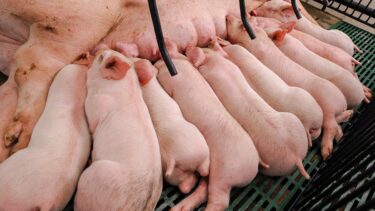Farrowing is top sport for the sow! How can we support her?
With the right feed and a well-thought-out feeding strategy, we can help sows obtain sufficient energy for more vital piglets at birth. This is why Earlyfeed is conducting research to gain insight into sow feed types and feeding strategies for the best support during farrowing. Today, Swine Researcher Moniek van den Bosch, from the Laverdonk Research Facility, explains some of the best ways to support sows before and during farrowing.
Laverdonk Research Facility is constantly testing new products for improvements to existing feeds. Here, the wishes and requirements of the market are translated into feed compositions, recommendations, and tools. This is how we, and our customers, stay ahead of the changing market. One research area we are fully committed to is the farrowing process of the sow.
An enthusiastic researcher driving this research task on nutrition around farrowing is Moniek van den Bosch who states, “when we support our sows more around farrowing and further discover what nutrients she needs, we can better facilitate the farrowing process. Providing a positive effect on the pig farmer’s returns.” During her Ph.D. research, Moniek looked at how to better support the sow around farrowing through nutrition. From this research and follow-up research, “we are translating the results into practical guidelines for management and feeding strategies around farrowing. The research gives pig farmers tools to reduce the number of stillborn piglets and mortality before weaning,” says Moniek.
Acidification during farrowing
It is known that the more piglets a sow gives birth to, the longer the farrowing process takes; with up to 27 additional minutes per extra piglet in a litter. The longer the farrowing takes, the more energy the sow needs. “Research shows that, just like athletes do when they exert a lot of effort, sows acidify during farrowing. When acidification occurs, glucose is the main source of energy to counteract this,” explains Moniek. The higher the glucose levels in the sow’s blood when the first piglet is born, the smoother the farrowing process goes. This is why Moniek believes it is “so important to feed high-yielding sows properly”.
When we talk about the farrowing process, we usually discuss the phase in which the piglets are born, but it includes a great deal of time before parturition. Even in the early phase of farrowing, the sow needs extra energy and other nutrients for nest-building behavior and the first contractions that cause the cervix to dilate.
Feeding strategies around farrowing
Moniek explains, “to ensure the sow has enough glucose in her blood during farrowing, we recommend increasing the number of meals around farrowing to three per day. See at what time most sows on your farm are farrowing and try to provide feed as close to that time as possible. If the sows are mainly farrowing at night, give also feed in the evening hours.”
This strategy replaces the outdated method of limiting a sow’s feed on the day of farrowing. The new recommendation for the optimal amount of feed on the day of farrowing is tailor-made and depends on the feed type as well as the production level of the sows. Moniek explains how “we are trying to gain more insight into this at our Laverdonk trial farm.”
Stress reduction: positive effect on oxytocin
In addition to good nutrition, the sow’s comfort also has a positive effect on the farrowing process. Since stress has an inhibiting effect on the production of the hormone oxytocin (which slows down contractions) “preventing stress with calm handling of the animals, a quiet environment, timely moving to the farrowing pen, and providing nesting material (e.g. a burlap sack) among other things can help. Additionally, when the possibility exists, letting the sow farrow loose can help lower stress.”
Support the sow for vital piglets
In the uterus, piglets receive blood and oxygen through the placenta and umbilical cord. If the umbilical cord cuts off prematurely—or breaks due to powerful and/or frequent contractions—the piglet does not receive enough oxygen during the birth process. This can lead to stillbirths or the birth of less vital piglets with a higher mortality risk. The longer the farrowing process takes, the higher the risk. This is why “the later-born piglets are more at risk of stillbirth or lower vitality,” Moniek explains.
Though the vitality of newborn piglets can be assessed by observation, Moniek states that “blood tests from the umbilical cord of piglets immediately after birth can also provide insight into vitality. Studies show that liveborn piglets with low oxygen levels in the umbilical cord blood are less vital and have a higher risk of dying before weaning.” Indicators of low vitality include difficulty getting up quickly and moving toward the udder or to a heat lamp to avoid hypothermia. These early actions are crucial because piglets are born wet and into a fairly cold environment with little fat reserves. A healthy and vital piglet is able to acquire a place at the udder and take up enough colostrum.


So, how is a vital piglet born? Earlyfeed is always researching and sharing the most recent developments with the industry. We do this to help our customers succeed by helping them keep their animals healthy and vital. We know who we are working for and we know what it takes to do it ‘right from the start’.
This contact was suggested based on the location you are browsing from. You can of course also consult our other contacts and locations here.

